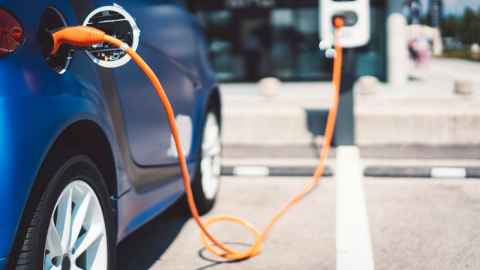Researchers are accelerating the drive towards more sustainable travel, investigating the feasibility of wireless in-lane charging for electric vehicles.

The impact of wireless electric vehicle (EV) charging pads on a section of Auckland motorway, including economic feasibility, charging lane length, effects on traffic flow and energy consumption, is examined in a recent study.
Dynamic wireless charging (DWC) pads are embedded into the road and use electromagnetic induction to charge electric vehicles while they're moving, says Business School research fellow Dr Selena Sheng.
"This offers a viable solution to mitigate issues related to EV use, including range anxiety and charging times."
Engineering PhD candidate Ramesh Majhi, Faculty of Engineering senior lecturer Dr Prakash Ranjitkar and Dr Sheng developed a traffic simulation framework and a 'state of charge' model to evaluate the impacts of DWC facilities using a 90km section of State Highway 1.
Their work, published in the international journal Sustainable Cities and Societies, titled Assessment of dynamic wireless charging based electric road system: A case study of Auckland motorway, used various scenarios and measures, including four different inductive power transfer capacities (50, 75, 100, and 125 kilowatts), real traffic data and two types of traffic conditions - peak hour and free flow, to evaluate the performance of dynamic wireless charging systems.
The study demonstrates that with an increase in inductive power transfer capacity, the total energy demand and the length of the charging section required decreases. As a wireless charging pad's power capacity increases from 50 kilowatts to 125 kilowatts, the cumulative length of charging sections required along the 90km corridor decreases from 34 percent to 12 percent, according to the study.
With the increase in charging demand, the wireless in-road facility will soon become more competitive than the current plug-in charging stations due to savings in costs associated with travel time, delay, and charging time.
Meanwhile, although the paper doesn't explore the total cost associated with implementing DWC in the transportation network, the researchers investigated the economic feasibility of the wireless system in terms of the total cost associated with a section of State Highway 1 by comparing it to the cost associated with using plug-in charging stations within 1km of the highway corridor.
"We found that the total investment cost of a DWC facility in the corridor for a system with a 50-kilowatt inductive power transfer capacity is $1.59 million per year when traffic flows freely compared to $1.42 million per year in the case of peak hour traffic."
The cost variation, says lead author Ramesh Majhi, is due to faster speeds when traffic moves freely; hence, more charging length is required to satisfy the demand.
Without considering the time it would take to drive to a static plug-in charging station, a wireless charging lane would only be less costly at 125 kilowatts and above, according to the paper.

However, when comparing the feasibility of both charging facilities in terms of the total cost, the researchers say it's imperative to consider the value of time (travel time, delay, and charging time), which is substantially more for plug-in charging stations compared to in-road wireless charging.
At a higher inductive power transfer capacity, such as 75 kilowatts and above, the wireless in-road charging facility becomes less costly compared to the typical plug-in set-up under peak-hour conditions while taking the cost of travel time into account.
As the EV population increases, the time costs tend to become more significant to utilize plug-in charging stations, which will make dynamic wireless charging more feasible and competitive in the future, say the researchers.
"As the existing plug-in stations can handle only limited EVs at a given time, with the increase in charging demand, the wireless in-road facility will soon become more competitive compared to the current plug-in charging stations due to savings in costs associated with travel time, delay, and charging time," says Majhi.
"Moreover, with advanced research in dynamic wireless charging system components, the construction cost of a wireless charging lane will soon decrease, making it more feasible than existing plug-in charging."






